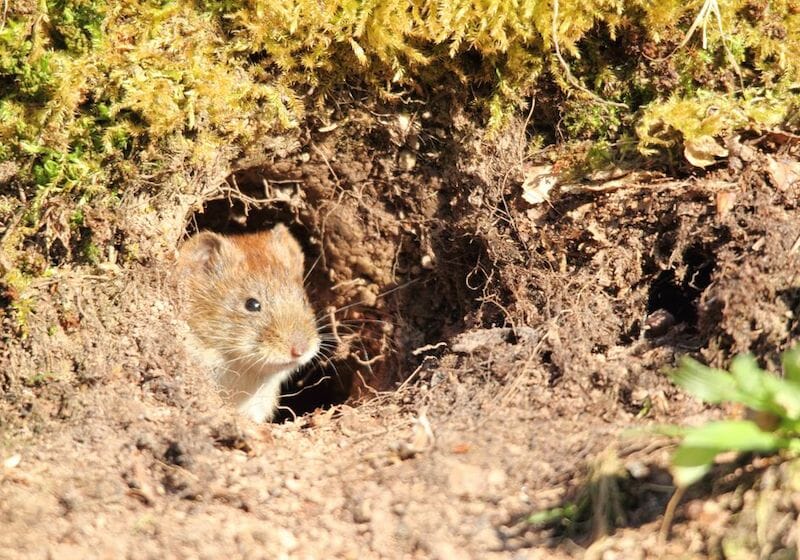Vole Lawn Damage Solutions: Effective Control Methods
Vole Lawn Damage Solutions: Effective Control Methods
Blog Article
Comprehensive Overview to Effective Vole Parasite Control: Infestation Identification and Therapy Approaches
In the world of reliable insect control, vole invasions pose a special obstacle that requires a calculated method. By checking out the subtleties of vole behavior, comprehending crucial indicators of infestation, and reviewing a range of control choices, one can establish a thorough strategy to deal with these evasive pests.
Understanding Vole Behavior
Vole habits is defined by their tunneling habits and fast reproduction rates, making them a tough parasite to regulate efficiently. These small rodents normally develop detailed passage systems underground, utilizing them for sanctuary, food storage space, and transport. Voles are herbivores, taking in a variety of plants, light bulbs, yards, and origins, which can cause significant damage to gardens, orchards, and grass. Their quick reproductive price additional complicates control efforts, with ladies efficient in producing several litters in a single year, each containing numerous children.
Voles are most active throughout the morning and evening hours, investing the majority of their time foraging for food. Their burrowing habits not just disturb yards and lawns but also make them testing to spot and eliminate. Understanding vole habits is vital for effective bug control techniques. By recognizing their burrow places, keeping an eye on feeding areas, and applying targeted control techniques, such as capturing or habitat alteration, vole infestations can be taken care of effectively.
Indications of Vole Problem

Avoidance Strategies
Applying efficient avoidance strategies is vital in minimizing vole invasions and guarding vegetation from their devastating feeding behaviors (vole lawn damage). To avoid vole infestations, it is vital to begin by removing potential food sources and shelter. Keep turf and plants cut short, get rid of weeds and particles, and maintain a tidy garden or lawn to make the area much less eye-catching to voles. Mounting obstacles such as hardware cloth or below ground fencing can also assist prevent voles from getting in specific locations. In addition, reducing excess moisture by repairing leaking pipes and guaranteeing appropriate drain can make the atmosphere less congenial for voles.
On a regular basis evaluating the residential property for indications of vole task, such as runways and tunnel openings, is crucial for early discovery and prompt activity. Consider using traps or repellents strategically positioned near their paths if vole activity is believed. Utilizing natural killers like owls or serpents can also aid keep vole populations in check. By executing a combination of these prevention garden enthusiasts, strategies and homeowners can successfully protect their plants from vole damage.
Non-Lethal Control Methods
To successfully take care of vole populations while prioritizing humane techniques, non-lethal control approaches provide functional solutions for minimizing vole damage in landscapes and yards. One reliable method is making use of physical obstacles such as equipment cloth over here or wire mesh to shield susceptible plants. These obstacles can be hidden at least 12 inches deep and curved at a 90-degree angle to avoid voles from tunneling beneath. Furthermore, habitat adjustment can prevent voles by minimizing their liked food resources and hiding areas. Maintaining a well-mowed lawn, removing debris, and maintaining vegetation trimmed can make the environment much less enticing to voles.

Lethal Control Options
One reliable approach for resolving vole problems in yards and landscapes involves the strategic use of lethal control options. When faced with a serious vole problem that non-lethal approaches have stopped working to include, carrying out dangerous control measures comes to be critical. On the whole, when utilizing lethal control alternatives, it is necessary to do so properly and in accordance with regional policies to effectively take care of vole infestations.
Verdict
In final thought, effective vole parasite control needs a comprehensive understanding of vole actions, identification of indicators of invasion, execution of prevention strategies, and use of both non-lethal and deadly control techniques. By combining these techniques, people can successfully manage vole populations and shield their property from damages. It site web is essential to attend to vole infestations without delay to avoid more problems and decrease the influence on the surrounding atmosphere.
Given the detailed tunnel systems and quick reproduction prices characteristic of voles, acknowledging the indications of vole problem becomes necessary in effective reference insect control. One of the key indicators of vole presence is the existence of surface runways or tracks in grass or snow, normally about 1-2 inches broad, developed as voles take a trip between their burrows and food sources.To successfully take care of vole populaces while prioritizing gentle methods, non-lethal control approaches provide sensible solutions for decreasing vole damage in landscapes and yards.One effective technique for dealing with vole invasions in landscapes and yards involves the strategic use of lethal control options. vole control utah.In conclusion, reliable vole parasite control calls for a thorough understanding of vole actions, recognition of indications of invasion, implementation of prevention techniques, and usage of both non-lethal and deadly control methods
Report this page